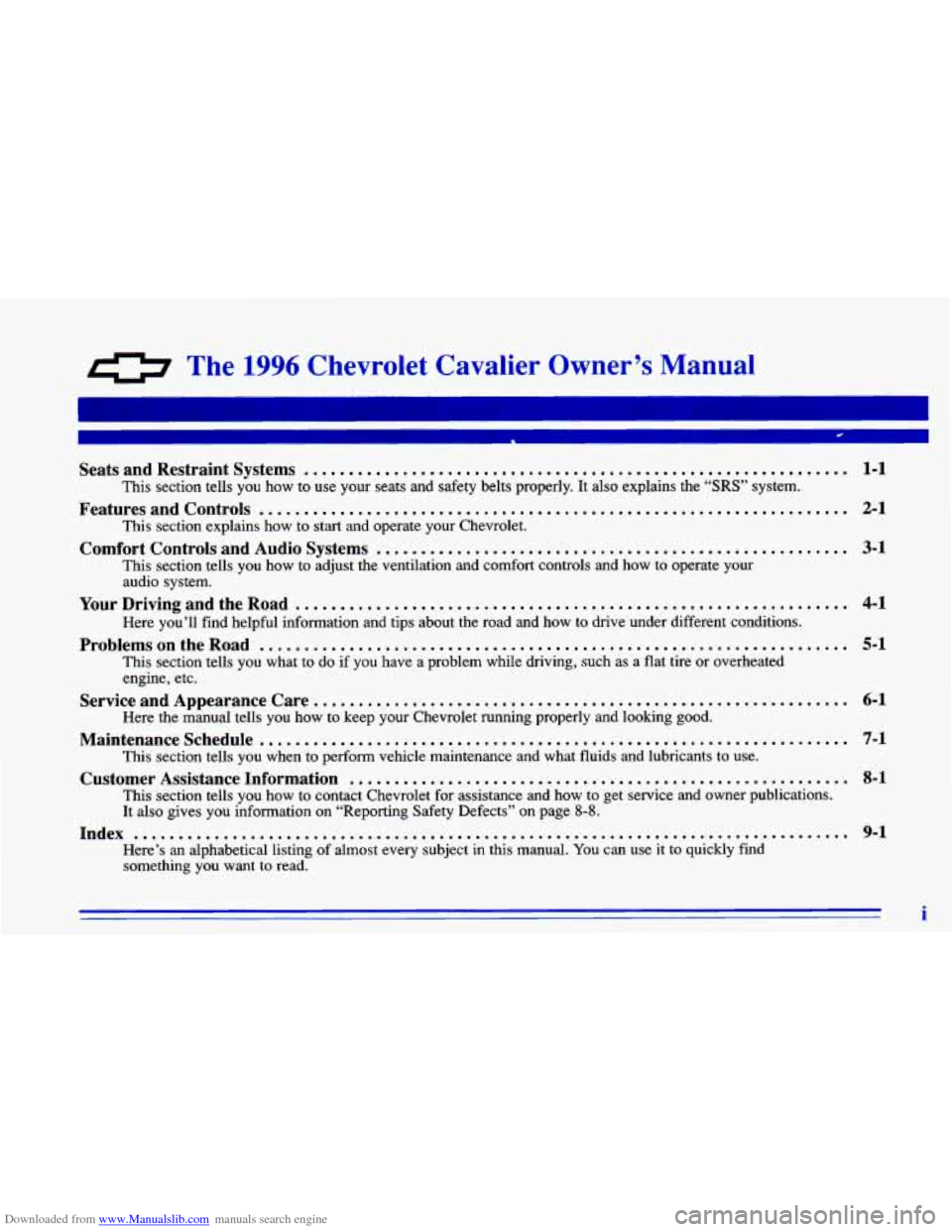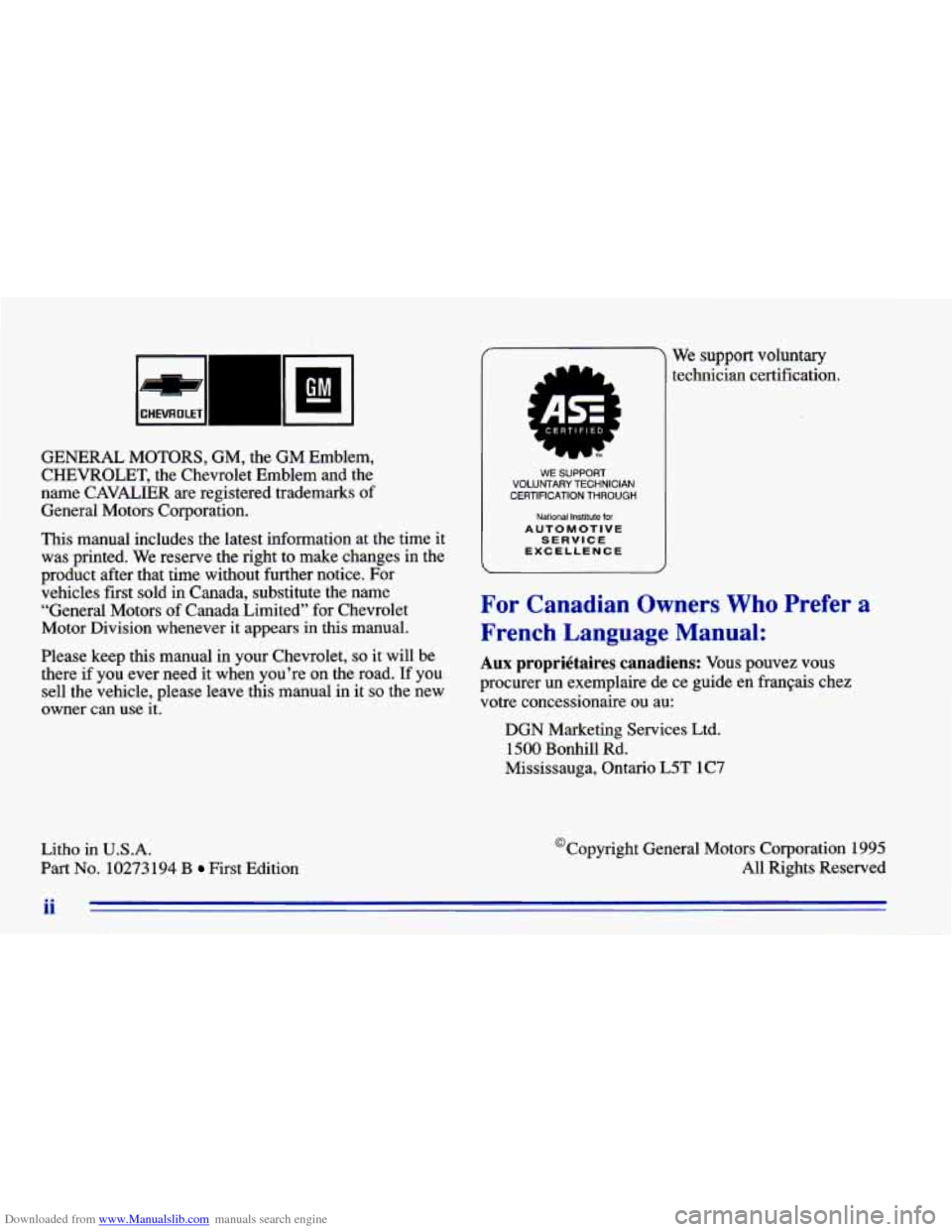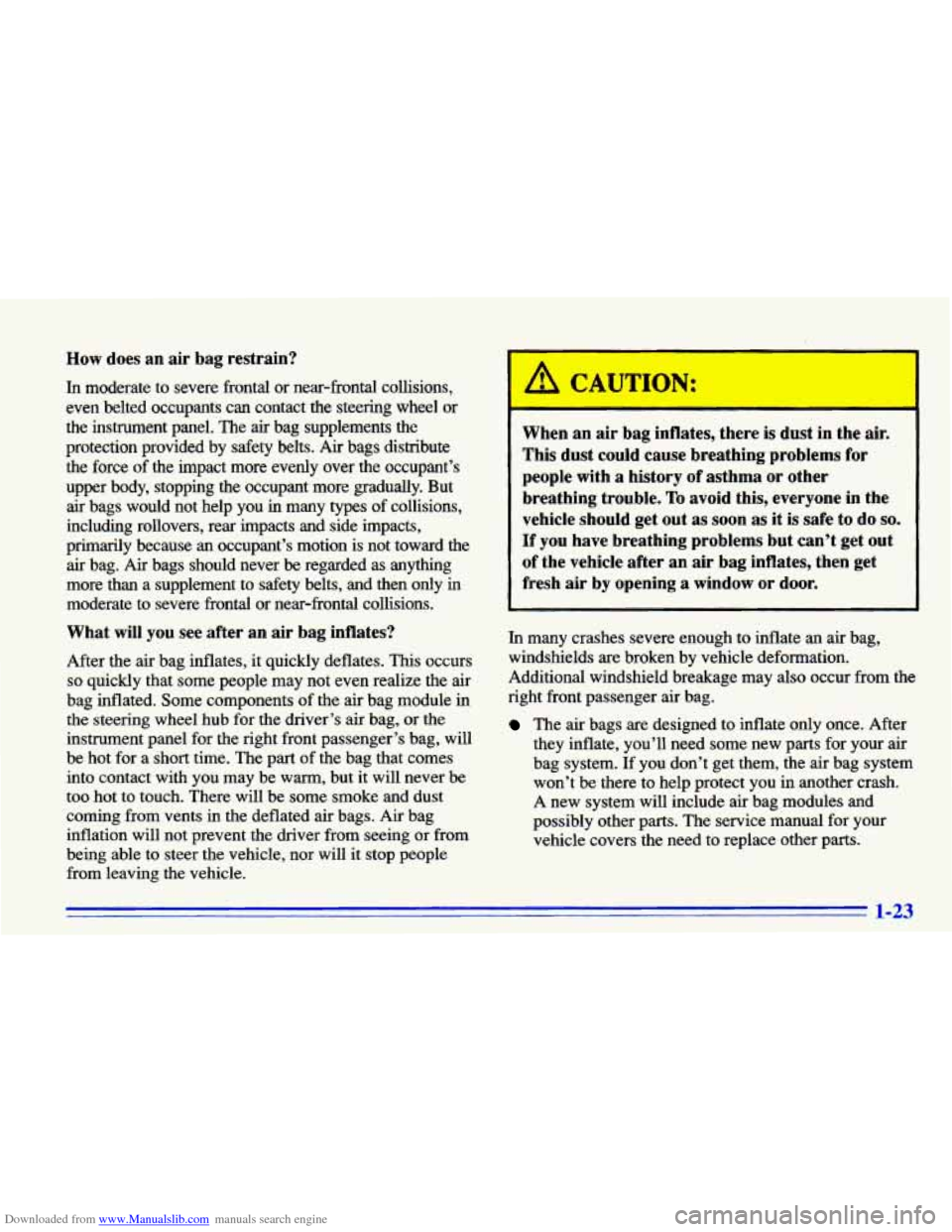1996 CHEVROLET CAVALIER service
[x] Cancel search: servicePage 3 of 372

Downloaded from www.Manualslib.com manuals search engine 0 The 1996 Chevrolet Cavalier Owner’s Manual
SeatsandRestraintSystems ............................................................. 1-1
This section tells you how to use your seats and safety belts prop\
erly. It also explains the “SRS” system.
.. FeaturesandControls ................................................................... 2-1
Comfort Controls and Audio Systems ..................................................... 3-1
This section explains how to start and operate your Chevrolet. \
This section tells
you how to adjust the ventilation and comfort controls and how to \
operate your
audio system.
YourDrivingandtheRoad .............................................................. 4-1
Here you’ll find helpful information and tips about the road\
and how to drive under different conditions.
ProblemsontheRoad .................................................................. 5-1
This section tells you what to do if you have a problem whil\
e driving, such as a flat tire or overheated
engine, etc.
ServiceandAppearanceCare ............................................................ 6-1
Here the manual tells you how to keep your Chevrolet running \
properly and looking good.
Maintenance Schedule .................................................................. 7-1
This section tells you when to perform vehicle maintenance and \
what fluids and lubricants to use.
Customer Assistance Information ........................................................ 8-1
This section tells you how to contact Chevrolet for assistance and how to get service\
and owner publications.
It also gives
you information on “Reporting Safety Defects” on page 8-8.
Here’s an alphabetical listing of almost every subject in this manual. You can use it to quickly find
something you want to read.
Index ........................................................................\
........ 9-1
i
Page 4 of 372

Downloaded from www.Manualslib.com manuals search engine GENERAL MOTORS, GM, the GM Emblem,
CHEVROLET, the Chevrolet Emblem and the
name CAVALIER are registered trademarks of
General Motors Corporation.
This manual includes the latest information at the time it
was printed. We reserve the right to make changes in the
product after that time without further notice. For
vehicles first sold in Canada, substitute the name
“General Motors of Canada Limited” for Chevrolet
Motor Division whenever it appears in
this manual.
Please keep this manual in your Chevrolet,
so it will be
there
if you ever need it when you’re on the road. If you
sell the vehicle, please leave this manual in
it so the new
owner can use
it.
Litho in U.S.A.
Part No. 10273 194 B First Edition
WE SUPPORT
VOLUNTARY TECHNICIAN
CERTIFICATION THROUGH
National institute for AUTOMOTIVE SERVICE
EXCELLENCE
L
We support voluntary
technician certification.
For Canadian Owners Who
French Language Manual:
refer a
Aux propriktaires canadiens: Vous pouvez vous
procurer
un exemplaire de ce guide en frangais chez
votre concessionaire ou au:
DGN Marketing Services Ltd.
1500 Bonhill Rd.
Mississauga, Ontario L5T 1C7
@Copyright General Motors Corporation 1995
All Rights Reserved
ii
Page 33 of 372

Downloaded from www.Manualslib.com manuals search engine How does an air bag restrain?
In moderate to severe frontal or near-frontal collisions,
even belted occupants can contact the steering wheel or
the instrument panel. The
air bag supplements the
protection provided by
safety belts. Air bags distribute
the
force of the impact more evenly over the occupant’s
upper body, stopping the occupant more gradually. But
air bags would not help you in many types of collisions,
including rollovers, rear impacts and side impacts,
primarily because an occupant’s motion is not toward the
air bag. Air bags should never be regarded as anythmg
more than a supplement to safety belts, and then only in
moderate
to severe frontal or near-frontal collisions.
What will you see after an air bag inflates?
After the air bag inflates, it quickly deflates. This occurs
so quickly that some people may not even realize the air
bag inflated. Some components of the air bag module in
the steering wheel hub for the driver’s air bag, or the
instrument panel for the right front passenger’s bag, will
be hot for a short time. The part
of the bag that comes
into contact with you may be warm, but it will never be
too hot to touch. There will be some smoke and dust
coming from vents in the deflated air bags. Air bag
inflation will not prevent the driver from seeing or from
being able to steer the vehicle, nor will
it stop people
from leaving the vehicle.
I
When an air bag inflates, there is dust in the air.
This dust could cause breathing problems for
people with a history
of asthma.or other
breathing trouble.
To avoid this, everyone in the
vehicle should get out as soon as
it is safe to do so.
If you have breathing problems but can’t get out
of the vehicle after an air bag inflates, then get
fresh air by opening
a window or door.
In many crashes severe enough to inflate an air bag,
windshields are broken by vehicle deformation.
Additional windshield breakage may also occur from the
right front passenger air bag.
The air bags are designed to inflate only once. After
they inflate, you’ll need some new parts for your
air
bag system. If you don’t get them, the air bag system
won’t be there to help protect you in another crash.
A new system will include air bag modules and
possibly other parts. The service manual for your
vehicle covers the need to replace other parts.
1-23
Page 34 of 372

Downloaded from www.Manualslib.com manuals search engine 0
,e
Your vehicle is equipped with a crash sensing
and diagnostic module, which records information
about the
air bag system. The module records
information about the readiness
of the system, when
the sensors are activated and driver’s safety belt
usage at deployment.
Let
only qualified technicians work on your
air bag system. Improper service can mean that
your
air bag system won’t work properly. See your
dealer for service.
Servicing Your Air Bag-Equipped
Chevrolet
Air bags affect how your Chevrolet should be serviced.
There are
parts of the air bag system in several places
around your vehicle. You don’t want
the system to
inflate while someone is working
on your vehicle. Your
Chevrolet dealer and the Cavalier Service Manual have
information about servicing your vehicle and
the air bag
system.
To purchase a service manual, see “Service and
Owner Publications”
in the Index.
NOTICE:
If you damage the cover for the’ driver’s or the
right front passenger’s
air bag, they may not
work properly. You may have to replace the
air
bag module in the steering wheel or both the air
bag module and the instrument panel for the
right front passenger’s
air bag. Do not open or
break the
air bag covers.
I
For up to 10 minutes after the ignition key is
turned off and the battery is disconnected, an air
bag can still inflate during improper service. You
can be injured
if you are close to an air bag when
it inflates. Avoid wires wrapped with yellow tape
or yellow connectors. They are probably part of
the
air bag system. Be sure to follow proper
service procedures, and make sure the person
performing work for you
is qualified to do so.
The air bag system does not need regular maintenance.
Page 64 of 372

Downloaded from www.Manualslib.com manuals search engine 0 Check the location. Other vehicles or objects may be
See your Chevrolet dealer or a qualified technician
blocking
the signal.
for service.
Changes
or modifications to this system by other than an
authorized service facility could void authorization to
use this equipment.
Operation
The driver’s door will unlock automatically when
UNLOCK is pressed.
If pressed again within five
seconds, all the doors will unlock. All doors will lock
when DOOR
is pressed.
The trunk will unlock anytime when the opened trunk
symbol on the Keyless Entry Control is pressed and
the ignition key is
OFF. On vehicles equipped with a
manual transaxle, the parking brake must be set.
Press DOOR or
UNLOCK to illuminate the interior
lamps. The lamps will then
go off after 40 seconds
when
UNLOCK is pressed and for a few seconds when
DOOR is pressed. When the ignition is turned on, the
lamps will also fade out. See “Illuminated Entry”
in
the Index.
Matching Tkansmitter(s) To Your Vehicle
Each key chain transmitter is coded to prevent another
transmitter from unlocking your vehicle. If a transmitter
is lost or stolen, a replacement can be purchased
through your dealer. Remember to bring
any remaining
transmitters with you when you
go to your dealer.
When the dealer matches the replacement transmitter
to
your vehicle, any remaining transmitters must also be
matched. Once the new transmitter is coded, the lost
transmitter will not unlock your vehicle. Each vehicle
can have only two transmitters matched to it.
Battery Replacement
Under normal use, the batteries in your key chain
transmitter should last about two years.
You can tell the batteries are weak if the transmitter
won’t work at the normal range in any location. If you
have to get close to your,vehicle before the transmitter
works, it’s probably time to change the batteries.
Page 67 of 372

Downloaded from www.Manualslib.com manuals search engine Passlock TM
Your vehicle is equipped with the Passlock
theft-deterrent system.
Passlock is a passive theft-deterrent system. The system is armed once the key is removed from the ignition. Passlock
enables fuel if the ignition lock cylinder is turned with a
valid key.
If a correct key is not used, fuel is disabled.
During normal operation, the THEFT SYSTEM light will
go off after the engine
is started. In the unlikely event that
the engine stalls and the THEFT SYSTEM light flashes,
wait until the light stops flashing before trying to restart
the engine. Remember to release the key from the START position as soon as the engine starts. If after several tries the vehicle still does not start, the vehicle
may need service. At this time, you may also want to
check the fuses (see “Fuses and Circuit Breakers” in the\
Index). See your Chevrolet dealer for service.
If the THEFT SYSTEM light comes on while the engine
is running, a problem has been detected and the system
may need service.
See your dealer for service.
In
an emergency, call the Chevrolet Roadside Assistance
Program at
1-800-CHEV-USA I 1-800-243-8872.
New Vehicle LLBreak-InT’
NOTICE:
Your modern Chevrolet doesn’t need an
elaborate “break-in.” But it will perform better
in the long run if you follow these guidelines:
Don’t drive at any one speed -- fast or
slow -- for the first 500 miles (804 km).
Don’t make full-throttle
starts.
200 miles (322 km) or so. During this time
your new brake linings aren’t yet broken
in. Hard stops with new linings can mean
premature wear and earlier replacement.
Follow this breaking-in guideline every
time you get new brake linings.
See “Towing
a Trailer” in the Index for
more information.
Avoid making hard stops for the first
Don’t tow a trailer during break-in.
2-9
Page 69 of 372

Downloaded from www.Manualslib.com manuals search engine On manual transaxle vehicles, turning the key to
LOCK will lock the steering column and result in
a loss of ability to steer the vehicle. This could
cause
a collision. If you need to turn the engine
off while the vehicle is moving, turn the key only
to
OFF. Don’t press the key release button while
the vehicle is moving.
NOTICE:
If your key seems stuck in LOCK and you can’t
turn it,
be sure it is all the way in. If it is, then
turn
the steering wheel left and right while you
turn the key hard. But turn the key only with
your hand. Using
a tool to force it could break
the key or
the ignition switch. If none of this
works, then your vehicle needs service.
Key Release Button (Manual Transaxle)
The ignition key cannot be
removed from the ignition
unless the key release
I button is used.
To remove the key, turn the key to the OFF position.
While pressing the key release button in, turn the
key to
the
LOCK position. Pull the key straight out.
2-11
Page 124 of 372

Downloaded from www.Manualslib.com manuals search engine Air Bag Readiness Light
There is an air bag readiness light on the instrument
panel, which shows
AIR BAG. The system checks the
air bag’s electrical system for malfunctions. The light
tells you if ,there’ is an electrical problem. The system
check includes the
air bag sensor, the air bag modules,
the wiring and the crash sensing and diagnostic module.
For more information on the air bag system, see “Air
Bag” in the Index.
AIR
BAG
You will see this light flash
,for a few seconds when you
turn your ignition to RUN
or START. Then the light
should go out. This means
the system is ready.
If the air bag readiness light doesn’t come on when you
start your vehicle, or stays on, or comes on when you
are driving, your
air bag system may not work properly.
Have your vehicle serviced right away.
Charging System Light
El
The charging system light
will come on briefly when
you
turn on the ignition, and
the engine is not running,
as
a check to show you it is
working. Then it should
go out.
If it stays on, or comes on while you are driving, you
may have a problem with the
electrical charging system.
It could indicate that you have a loose generator drive
belt, or another electrical problem. Have it checked
right away. Driving while this light is on could drain
your battery.
If you must drive a short distance
with the light on, be
certain to
turn off all yoq accessories, such as the radio
and
air conditioner.
2-66